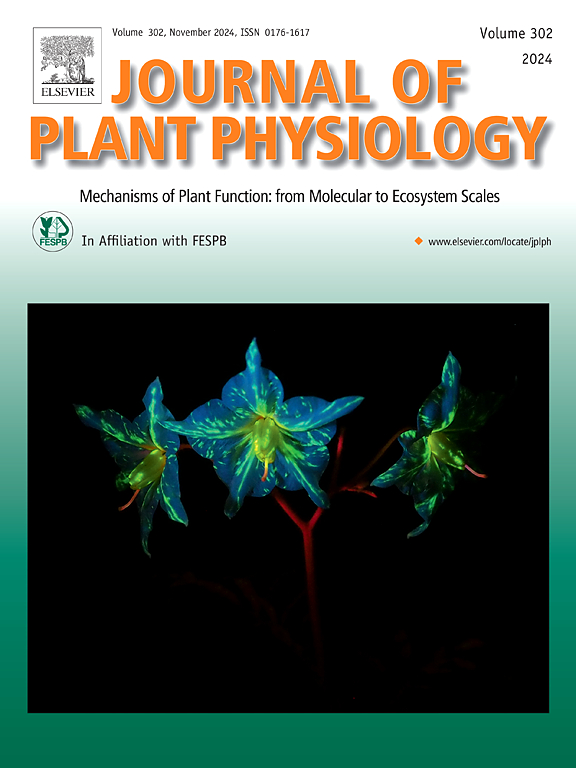HAE-FLS2嵌合体的自身免疫和免疫反应超激活
IF 4.1
3区 生物学
Q1 PLANT SCIENCES
引用次数: 0
摘要
植物利用细胞表面受体感知细胞外信号并启动适当的细胞反应,从而调节多种生理过程。富亮氨酸重复受体样激酶(LRR-RLK)型受体flagellin - sensitive 2 (FLS2)作为一种模式识别受体(PRR),特异性检测细菌鞭毛蛋白,激活下游反应,包括MAPK信号传导和ROS爆发。在这里,我们报道了将HAE的n端胞外和跨膜结构域与FLS2的胞质激酶结构域(HAE-FLS2)结合的嵌合受体的工程化表达,导致植物免疫反应过度激活,如侏儒症,flg22诱导的ROS爆发和MAPK激活增强,以及防御相关基因在转基因植物中的表达上调。嵌合转基因植物对细菌和真菌病原体表现出增强的抗病能力。值得注意的是,虽然在FLS2结构域引入激酶死亡突变(D997N)部分减弱了这些免疫反应,但自身免疫表型的持续存在表明存在d997相关的激酶活性依赖和独立的信号机制。遗传分析显示,hae - fls2介导的免疫主要依赖于BAK1/BKK1, BAK1 -5 BKK1突变背景中自身免疫表型的显著抑制证明了这一点。这些发现为阐明FLS2的激活机制奠定了基础,并为通过策略性地操纵RLK来设计植物对不同类型病原体的抗病能力提供了概念框架。本文章由计算机程序翻译,如有差异,请以英文原文为准。
Autoimmunity and hyperactivation of immune responses by HAE-FLS2 chimera
Plants employ cell surface receptors to perceive extracellular signals and initiate appropriate cellular responses, thereby regulating diverse physiological processes. The well-characterized leucine-rich repeat receptor-like kinases (LRR-RLK) type receptor FLAGELLIN-SENSITIVE 2 (FLS2) functions as a pattern recognition receptor (PRR) that specifically detects bacterial flagellin, activating downstream responses including MAPK signaling and ROS burst. Here, we report that engineered expression of a chimeric receptor combining the N-terminal extracellular and transmembrane domains of HAE with the cytosolic kinase domain of FLS2 (HAE-FLS2) leads to excessive activation of plant immune responses, as evidenced by dwarfism, enhanced flg22-induced ROS burst and MAPK activation, and upregulated expression of defense-related genes in transgenic plants. The chimeric transgenic plants exhibit enhanced disease resistance to bacterial and fungal pathogens. Notably, while the introduction of a kinase-dead mutation (D997N) in the FLS2 domain partially attenuated these immune responses, the persistence of the autoimmune phenotype suggests the existence of both D997-associated kinase activity-dependent and -independent signaling mechanisms. Genetic analysis revealed that HAE-FLS2-mediated immunity predominantly depends on BAK1/BKK1, as evidenced by substantial suppression of the autoimmune phenotype in the bak1-5 bkk1 mutant background. These findings establish the fundamental basis for elucidating FLS2 activation mechanisms and provide a conceptual framework for engineering plant disease resistance toward different types of pathogens through strategic manipulation of RLK.
求助全文
通过发布文献求助,成功后即可免费获取论文全文。
去求助
来源期刊

Journal of plant physiology
生物-植物科学
CiteScore
7.20
自引率
4.70%
发文量
196
审稿时长
32 days
期刊介绍:
The Journal of Plant Physiology is a broad-spectrum journal that welcomes high-quality submissions in all major areas of plant physiology, including plant biochemistry, functional biotechnology, computational and synthetic plant biology, growth and development, photosynthesis and respiration, transport and translocation, plant-microbe interactions, biotic and abiotic stress. Studies are welcome at all levels of integration ranging from molecules and cells to organisms and their environments and are expected to use state-of-the-art methodologies. Pure gene expression studies are not within the focus of our journal. To be considered for publication, papers must significantly contribute to the mechanistic understanding of physiological processes, and not be merely descriptive, or confirmatory of previous results. We encourage the submission of papers that explore the physiology of non-model as well as accepted model species and those that bridge basic and applied research. For instance, studies on agricultural plants that show new physiological mechanisms to improve agricultural efficiency are welcome. Studies performed under uncontrolled situations (e.g. field conditions) not providing mechanistic insight will not be considered for publication.
The Journal of Plant Physiology publishes several types of articles: Original Research Articles, Reviews, Perspectives Articles, and Short Communications. Reviews and Perspectives will be solicited by the Editors; unsolicited reviews are also welcome but only from authors with a strong track record in the field of the review. Original research papers comprise the majority of published contributions.
 求助内容:
求助内容: 应助结果提醒方式:
应助结果提醒方式:


